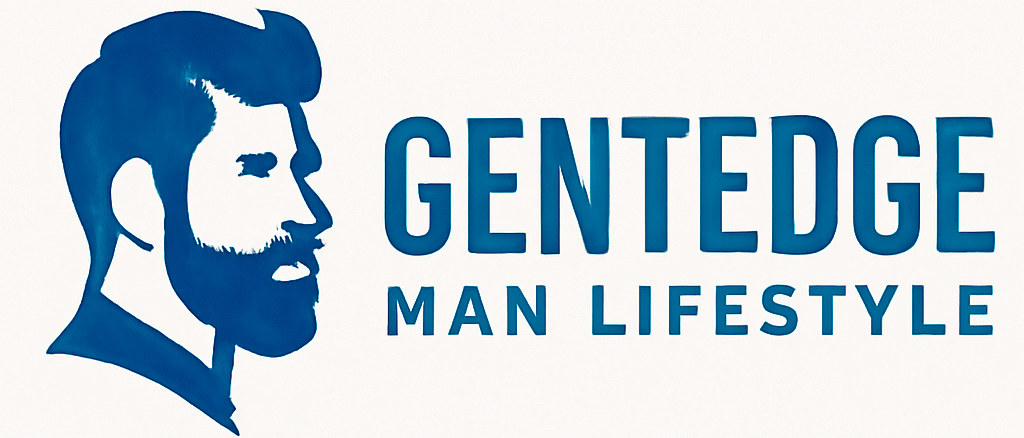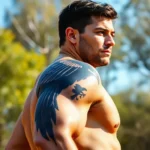We’ve all been there – staring at our reflection wondering how to tame those unruly curls without losing our natural texture. Men’s curly hair presents unique challenges that straight-haired guys simply don’t face. The wrong cut can leave you looking like you stuck your finger in an electrical socket while the right one transforms your curls into your greatest asset.
Finding the perfect haircut for men’s curly hair isn’t just about following trends – it’s about understanding your curl pattern working with your hair’s natural movement and choosing styles that enhance rather than fight your texture. Whether you’re dealing with loose waves or tight coils we know the struggle of wanting a cut that looks intentional and polished.
The good news? With the right techniques and knowledge you can unlock your curls’ full potential. We’re here to guide you through the best haircuts styling tips and maintenance secrets that’ll have you embracing those curls with confidence.
Understanding Your Curly Hair Type Before Choosing a Cut
We need to identify our exact curl characteristics before selecting the perfect haircut. This foundation ensures we choose cuts that enhance rather than fight against our natural texture.
Identifying Curl Patterns: Type 2, 3, and 4
Type 2 curls feature loose waves that range from barely there bends to more defined S-shaped patterns. We typically see Type 2A hair with gentle waves that lie close to the head, while Type 2B creates more pronounced waves with some frizz. Type 2C hair produces strong waves with occasional spiral curls mixed throughout.
Type 3 curls form distinct spiral patterns that bounce and spring back when stretched. Type 3A curls are large and loose with a circumference similar to sidewalk chalk. Type 3B curls are springier and tighter with a circumference like a Sharpie marker. Type 3C curls are tight and dense with a circumference similar to a pencil or drinking straw.
Type 4 curls create the tightest curl patterns with Z-shaped bends rather than spirals. Type 4A hair forms soft coils that are visible and springy. Type 4B hair creates a less defined pattern that bends in sharp angles. Type 4C hair appears almost straight until stretched and shows the least defined curl pattern.
Assessing Hair Density and Porosity
Hair density refers to how many individual strands we have per square inch on our scalp. Low density means we can easily see our scalp through our hair when it’s wet. Medium density allows us to see some scalp but not clearly. High density hair completely covers the scalp even when wet.
Hair porosity determines how well our hair absorbs and retains moisture. We can test porosity by dropping a clean strand in water and timing how long it takes to sink.
| Porosity Level | Sink Time | Characteristics |
|---|---|---|
| Low Porosity | Floats for several minutes | Repels moisture, takes long to get wet |
| Medium Porosity | Sinks in 2-4 minutes | Absorbs and retains moisture well |
| High Porosity | Sinks immediately | Absorbs moisture quickly but loses it fast |
Considering Face Shape and Lifestyle
Face shape compatibility plays a crucial role in selecting flattering cuts for our curly hair. Oval faces work well with most curl styles since the natural proportions are already balanced. Round faces benefit from cuts that add height and reduce width at the sides. Square faces need softening around the jawline through layered curls. Heart shaped faces require volume at the chin level to balance a wider forehead.
Lifestyle factors significantly impact our haircut choices and maintenance routines. Active lifestyles demand low maintenance cuts that look good even after workouts or outdoor activities. Professional environments might require more polished styles that can be easily shaped for business settings. Time constraints for morning routines influence whether we can handle cuts that need daily styling versus wash and go options.
Styling commitment levels vary dramatically among men with curly hair. Some prefer cuts that require minimal daily effort and air dry naturally. Others enjoy spending time perfecting their curl definition with products and techniques. We should match our haircut complexity to our realistic styling habits rather than aspirational ones.
Classic Curly Cuts That Never Go Out of Style
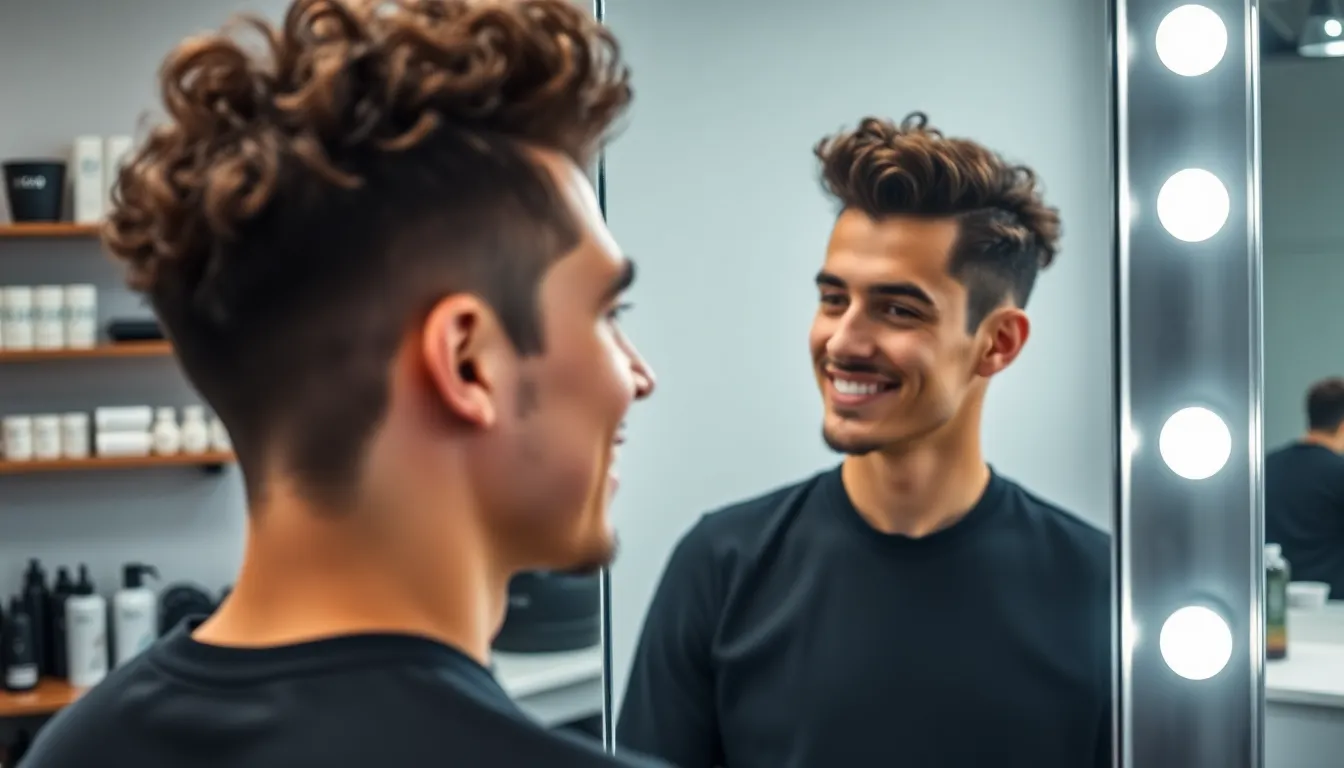
These enduring styles work beautifully with your natural curl pattern while offering professional versatility that transcends temporary trends.
The Timeless Curly Quiff
Sweeping your curls up and away from your face creates an instantly sophisticated look that adapts to any occasion. This versatile style works particularly well for men with Type 2 to Type 3 curls who want to add height and volume to their appearance.
We recommend using a light hold product to maintain the quiff’s shape without weighing down your natural texture. The beauty of this cut lies in its flexibility—you can style it sleek for business meetings or embrace a messier approach for casual settings.
Face shapes with longer proportions benefit most from this style since the upward movement creates visual balance. Your stylist should leave enough length on top to achieve the characteristic sweep while keeping the sides proportionate to your curl density.
Traditional Side Part for Curly Hair
Parting your curly hair to one side and sweeping it across your forehead delivers a timeless elegance that works across all professional environments. This classic approach particularly flatters men with oval and square face shapes by softening angular features.
Enhanced styling comes from using pomade or wax for both hold and shine, as these products help define your curl pattern while maintaining the part’s clean line. We suggest applying product to damp hair for even distribution and better curl definition.
Your barber should create a distinct part line that works with your natural growth patterns rather than against them. Men with Type 2 waves often find this style easiest to maintain, though Type 3 curls can achieve excellent results with proper product application.
Classic Taper Cut with Natural Texture
Clean lines paired with showcased natural texture make the taper cut a popular choice that bridges traditional barbering with modern curl appreciation. This style offers professional polish while celebrating your hair’s inherent movement and volume.
Styling products add definition to enhance the contrast between the tapered sides and textured top. We often pair this cut with a side part to create additional visual interest and structure.
The taper’s versatility allows customization based on your curl type and face shape—tighter curls benefit from more gradual tapering, while looser waves can handle more dramatic length differences. Your maintenance routine becomes simpler since the shorter sides require less daily styling while the longer top showcases your curl pattern’s natural beauty.
Modern Fade Variations for Curly Hair
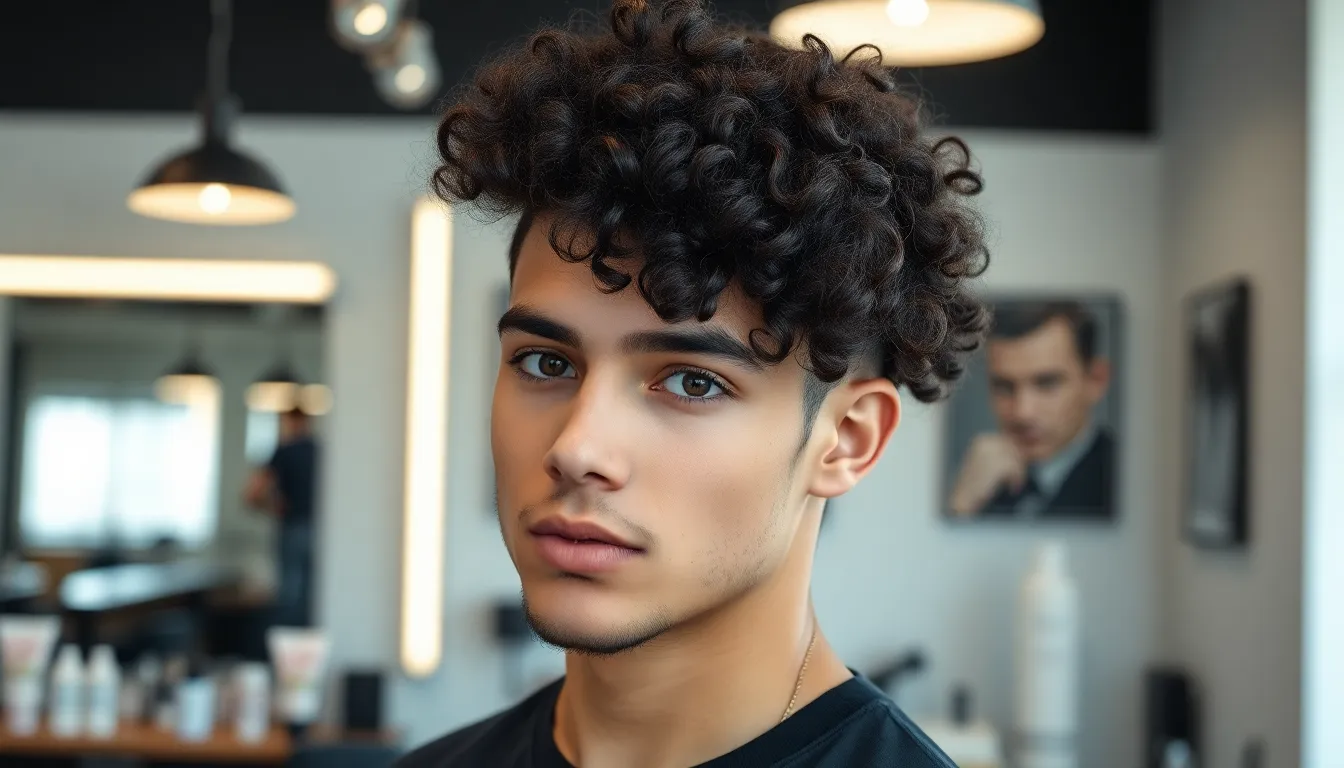
Building on those classic cuts, we’re now exploring contemporary fade techniques that perfectly complement curly textures while adding modern flair to your style.
Low Fade with Curly Top
Starting close to your neckline, this subtle fade gradually tapers upward while preserving your natural curl volume on top. The low fade creates a gentle contrast between cleanly trimmed sides and your textured curls without overwhelming your hair’s natural pattern.
We recommend this style for men who want professional polish without sacrificing their curl personality. Your curls remain the focal point while the fade adds structure and removes bulk from the sides. This versatile cut works exceptionally well with Type 2 to Type 3 curls and requires minimal daily styling.
Mid Fade for Balanced Proportions
Positioned around the middle of your head’s sides and back, the mid fade offers the perfect balance between subtle and striking. This technique showcases your curls prominently while maintaining clean, proportioned lines that flatter most face shapes.
Your styling options expand dramatically with this cut, from messy curly fringes to textured tops that emphasize your natural curl pattern. We’ve seen this fade work beautifully with everything from loose waves to tight coils, making it one of our most recommended styles for curly hair.
Adding shaved lines or design elements becomes effortless with this foundation, giving you creative freedom to personalize your look.
High Fade for Maximum Contrast
Creating the boldest statement, the high fade starts near your temples and crown for maximum visual impact. This dramatic technique sharply defines the difference between your closely shaved sides and voluminous curly top.
We suggest this cut for men who want an edgy, contemporary look that turns heads. Your curls become the undeniable star of the show, sitting prominently above the clean fade line. This style pairs exceptionally well with defined curl patterns and can incorporate artistic shaved designs that highlight accessories like ear jewelry.
The high contrast effect makes this fade ideal for showcasing tight curls or coils in a high top fade variation, delivering that coveted modern aesthetic.
Textured Cuts That Enhance Natural Curl Definition

Textured cuts work with your natural curl pattern rather than against it, using specialized cutting techniques to bring out the best in every curl. We’ll explore three standout textured styles that maximize curl definition while maintaining easy styling.
Layered Cuts for Volume and Movement
Layered cuts address the most common curly hair challenge: excessive bulk that creates unflattering triangular shapes. Stylists cut curls at different lengths to create balanced proportions and ever-changing movement throughout your hair.
Volume increases naturally when layers reduce weight distribution across your curls. The varied lengths allow air to flow between curl formations, preventing the flat, compressed look that single-length cuts often create.
Movement becomes effortless as each layer catches light differently and bounces independently. Medium to longer curly hair benefits most from this technique, as the additional length provides more layering opportunities.
Shrinkage appears minimized because layers create the illusion of fuller, more substantial hair. Professional stylists use point-cutting techniques within the layering process to avoid harsh lines that disrupt curl flow.
Undercut with Textured Crown
Undercuts combine the sharp precision of faded sides with the natural texture of longer crown curls. We see this style gaining popularity because it offers both professional polish and creative curl expression.
Contrast becomes the defining feature as short sides emphasize the textured curls on top. The crown section typically measures 2-3 inches, providing enough length for curl formation while maintaining manageability.
Styling remains minimal since the undercut structure does most of the work. Most men find they need only light curl cream or mousse to enhance the crown texture without weighing down the curls.
Maintenance requires regular side trimming every 2-3 weeks, but the crown curls can grow longer between cuts. Face shape compatibility makes this style particularly flattering for square and oval faces.
Shag Cut for Relaxed Style
Shag cuts embrace the deliberately tousled aesthetic that celebrates curl unpredictability. This layered approach creates intentional disorder that looks effortlessly stylish rather than unkempt.
Casualness defines the shag’s appeal as it works with curls’ natural tendency to fall in different directions. The varied lengths frame your face while reducing overall hair weight through strategic layering.
Freedom from rigid styling routines makes shags perfect for men who prefer wash-and-go simplicity. Medium to longer curly hair responds best to this cut, as shorter lengths don’t provide enough material for the characteristic shag texture.
Product requirements stay minimal with curl-exact creams or leave-in conditioners being sufficient for definition. The shag’s forgiving nature means slight variations in curl behavior actually enhance the intended relaxed appearance.
Length-Based Options for Different Curl Types
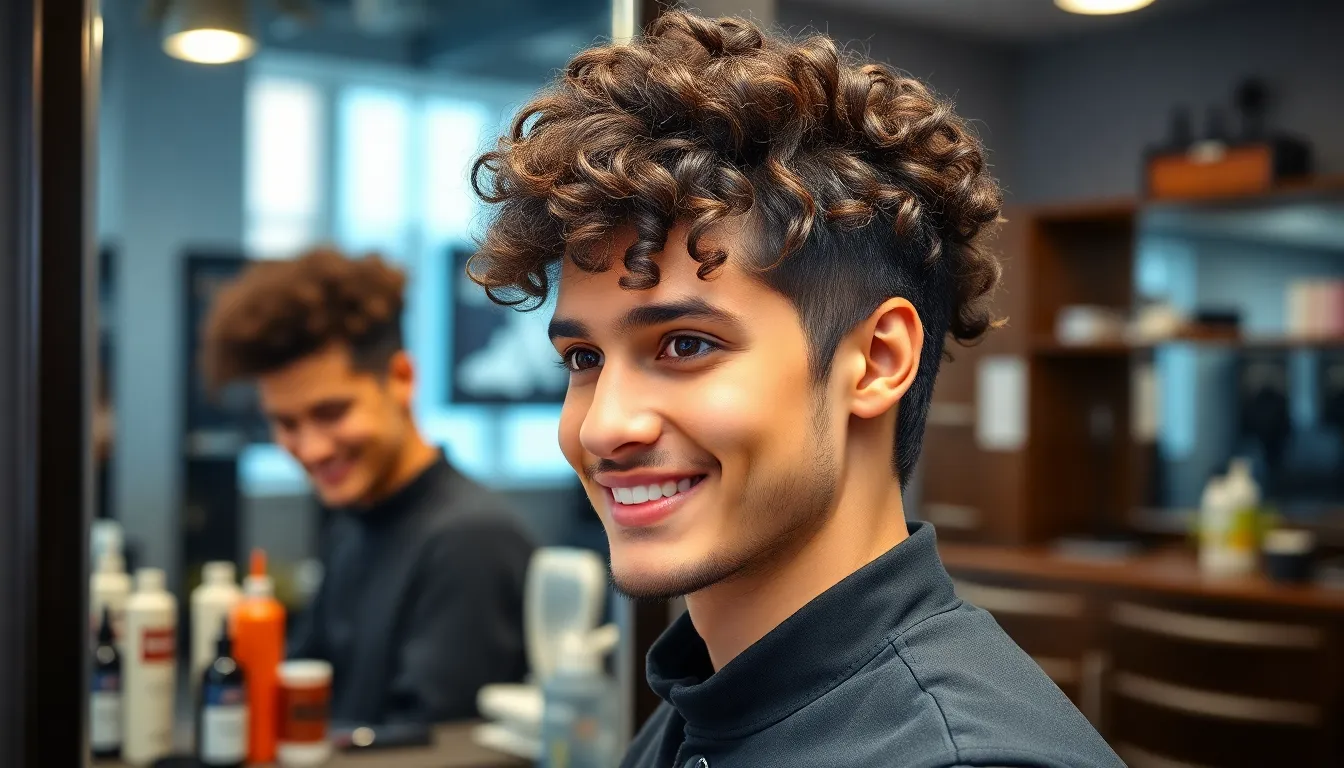
We’ve explored classic cuts and modern fades, but length plays a crucial role in determining how your curls will behave and look. Different lengths offer unique advantages for styling and maintenance.
Short Curly Cuts for Easy Maintenance
Short curly hairstyles focus on creating neat, polished looks while improving your natural curl pattern. We recommend these styles for men seeking low maintenance yet stylish options that won’t require extensive daily styling routines.
Curly Undercut delivers a clean, defined contrast by featuring short sides with longer curls on top. This cut highlights your curls while keeping the edges tidy and professional. Fades or tapers on the sides add a modern touch that complements the textured crown perfectly.
Curly Crew Cut adapts the traditional straight hair style for curly textures when combined with strategic fades. The result creates texture and sharpness that works exceptionally well for active lifestyles and professional environments.
Curly Hair Fade incorporates fades on the sides and back with curly tops to maximize volume and movement. High fades provide boldness for those wanting to make a statement, while low fades offer a subtle approach for conservative preferences. Using curl improving products helps define your curls and boost natural volume.
Medium-Length Styles for Versatility
Medium length curly hair around 2 to 4 inches balances manageability with styling versatility perfectly. This length suits most curl types and face shapes while allowing for different styling approaches like side parts or natural shaping.
Side Part Sweep creates a sophisticated look by parting your hair deeply to one side and sweeping curls across the forehead. Enhanced with pomades or waxes, this style adds shine and control while maintaining a polished appearance for both casual and formal occasions.
Curly Mullets and aesthetic medium curly styles have gained popularity for those wanting fashionable yet versatile looks. These cuts allow you to experiment with texture, volume, and curl definition while maintaining enough length for styling flexibility throughout the week.
Medium length cuts provide the sweet spot where you can showcase your curl pattern without overwhelming maintenance requirements or styling complexity.
Longer Cuts for Maximum Curl Expression
Longer curly hairstyles allow your curls to fully express their natural pattern and volume potential. We find these styles work best for men who want to make their curls the focal point of their overall look.
Tapered Curls combine longer tops with faded or tapered sides to create a polished yet voluminous appearance. This style maintains professionalism while showcasing the full beauty of your curl pattern from root to tip.
Bundled Curls with Undercuts pair longer curls on top with shaved or faded sides to create dramatic contrast and bold style statements. The length on top allows curls to form natural bundles and spirals that create movement and visual interest.
Long curls require more care to maintain definition and prevent frizz, but they provide maximum curl visibility and personal expression opportunities. Regular moisturizing treatments and curl improving products become essential for keeping longer curls healthy and well defined.
| Length | Style Examples | Key Features |
|---|---|---|
| Short | Curly undercut, crew cut, fades | Easy maintenance, neat sides, textured tops |
| Medium (2-4″) | Side part sweep, curly mullets | Versatile styling, balanced manageability |
| Long | Tapered curls, bundled curls | Maximum expression, volume, higher maintenance |
Professional Styling Tips for Curly Haircuts
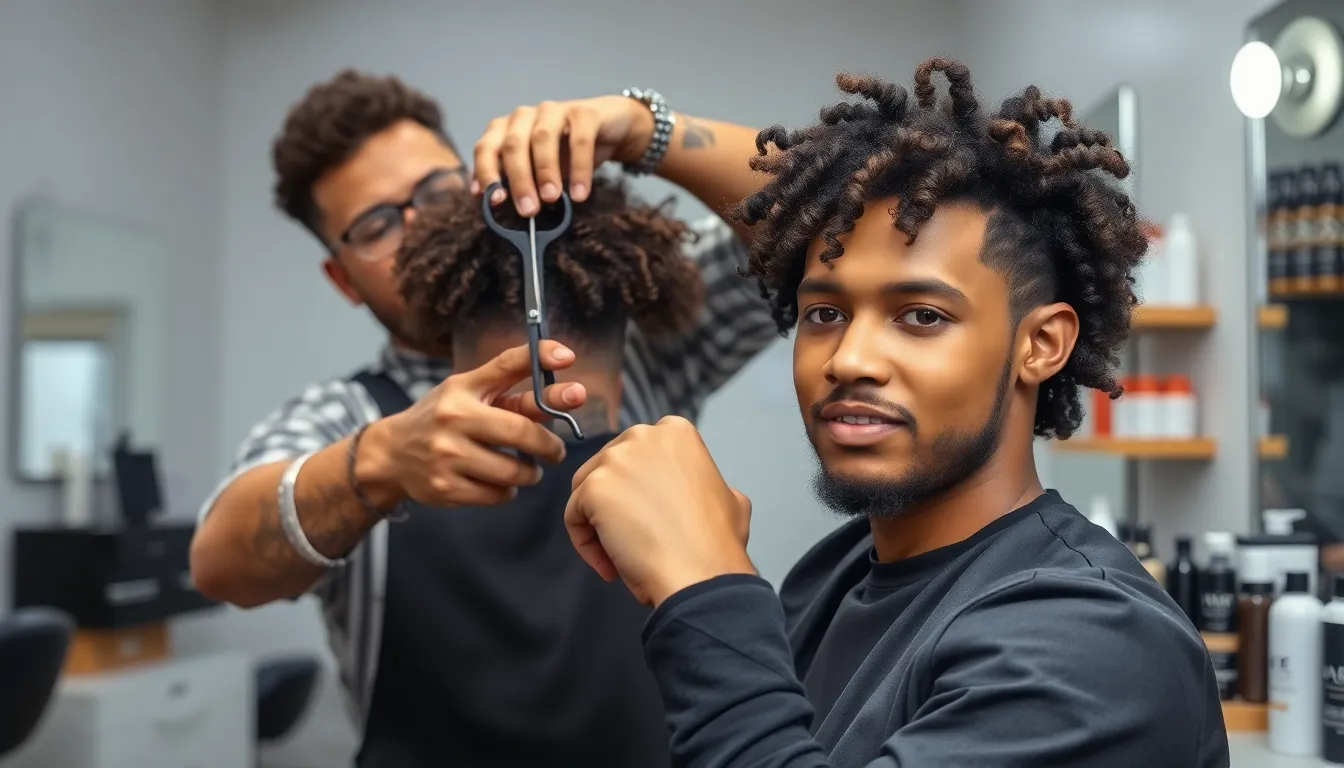
Working with a skilled barber who understands curly hair makes all the difference in achieving your ideal look. We recommend finding professionals who cut curly hair dry to see how your curls naturally fall and tailor the cut accordingly.
Best Products for Curl Enhancement
Hydrating shampoos and conditioners designed specifically for curly hair form the foundation of any effective curl routine. We’ve found that these specialized formulas maintain moisture in curls and prevent the limpness that generic products often cause.
Deep conditioning treatments applied every three weeks nourish curls from root to tip while promoting softness and manageability. Our experience shows that consistent deep conditioning significantly improves curl definition and reduces breakage over time.
Curl creams, gels, mousses, and sprays formulated for curly textures provide definition without weighing down your curls. We suggest experimenting with different product combinations to find what works best for your exact curl pattern and density.
Anti-frizz serums applied after drying combat humidity-induced frizz while adding natural shine to your curls. These products work particularly well when applied to slightly damp hair before final styling.
Drying Techniques That Preserve Shape
Air drying remains our top recommendation for minimizing heat damage and preserving your curl’s natural shape. This method allows curls to form their optimal pattern without interference from heat styling tools.
Diffuser attachments on low heat settings provide an alternative when time constraints make air drying impractical. We suggest using gentle, circular motions to evenly dry curls without disrupting their natural pattern.
Alternative styling methods such as twist-outs or bantu knots on damp hair create defined curls without any heat damage. These techniques work especially well for men with tighter curl patterns who want enhanced definition.
Daily Maintenance Routines
Regular shampooing and conditioning keep curls clean and healthy while helping to revive curl springs and bounce. We recommend establishing a consistent wash schedule based on your hair’s oil production and lifestyle needs.
Moisturizing curls daily with leave-in conditioners or light oils helps sustain hydration and elasticity throughout the day. This practice prevents dryness and maintains curl definition between wash days.
Consistent trimming of damaged ends every 6-8 weeks maintains hair health and encourages growth while preventing split ends from traveling up the hair shaft. We emphasize that regular maintenance trims are crucial for keeping curly cuts looking fresh and defined.
Avoiding excessive heat styling prevents dryness and split ends that can compromise your curl pattern over time. When heat is necessary, we always recommend using heat protectant products and the lowest effective temperature setting.
Common Mistakes to Avoid When Cutting Curly Hair
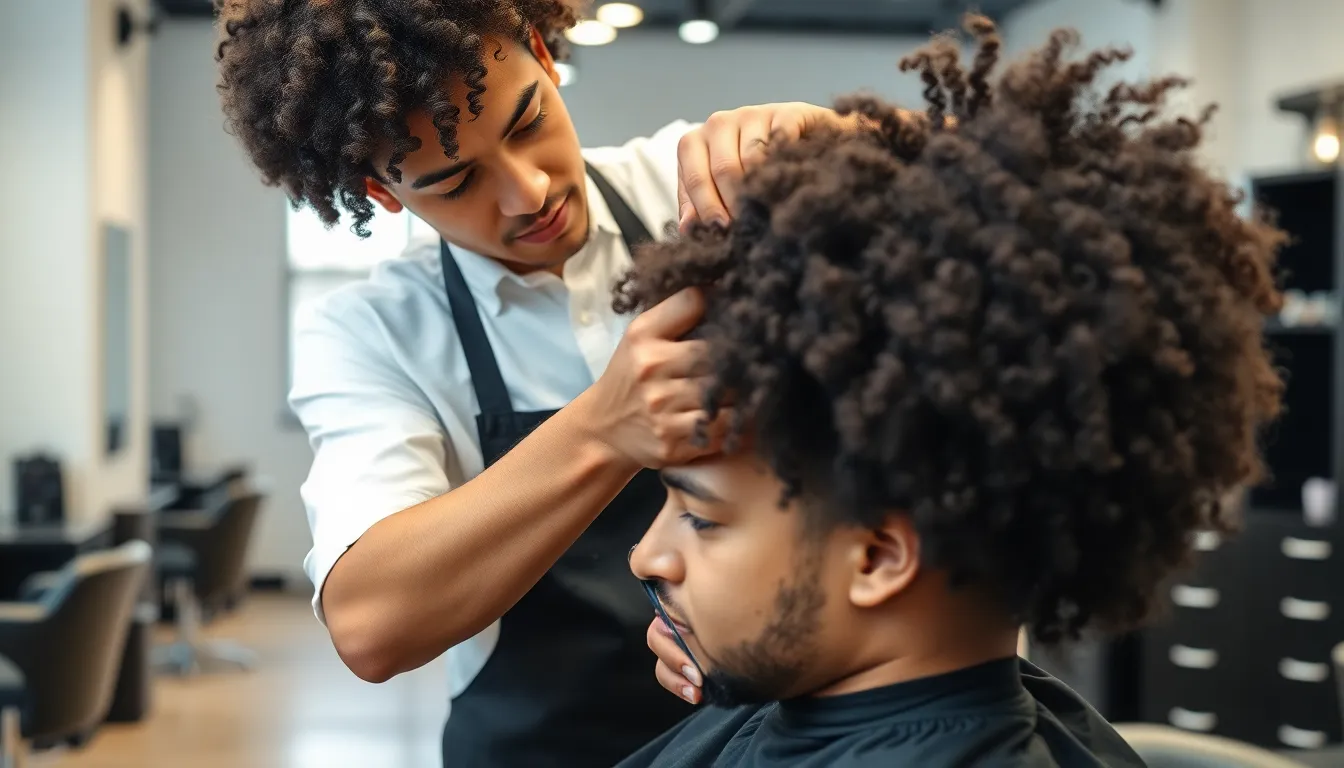
Understanding these common pitfalls can save you from a disappointing haircut and help preserve your natural curl pattern. We’ll explore the most frequent errors that occur during curly hair cutting and how to prevent them.
Over-Thinning and Excessive Layering
Thinning shears create uneven curls and unwanted puffiness when used excessively on curly hair. We see this mistake frequently because stylists apply straight hair techniques to curly textures without considering how curls behave differently.
Excessive layering compromises curl integrity and makes styling more difficult than necessary. Curly hair naturally shrinks as it dries, so removing too much volume creates unpredictable shapes that resist styling efforts.
Light point cutting offers better texture balance without destroying the natural curl formation. This technique preserves the hair’s ability to spring back into its natural pattern while reducing bulk strategically.
Heavy layer removal results in styling difficulties that can frustrate even experienced curly hair enthusiasts. We recommend asking your stylist to work conservatively with layering to maintain your curl’s natural movement and definition.
Cutting Hair When Wet vs. Dry
Cutting fully wet curly hair produces unexpected outcomes after the drying process because curls contract and change shape dramatically. We’ve observed that this traditional cutting method often leaves clients surprised by their final length and overall shape.
Trimming curls dry allows accurate assessment of natural fall and curl behavior patterns. This approach ensures consistent, balanced results because stylists can see exactly how each curl wants to behave in its natural state.
Some stylists prefer dampening hair for control but avoid oversaturating the strands during the cutting process. Moisture can stretch curls and lead to misjudgment in length, creating uneven results once the hair returns to its natural state.
Dry cutting techniques provide better length prediction and help maintain the curl’s natural spring factor. We recommend specifically requesting this method when booking appointments with new stylists who may not specialize in curly hair.
Ignoring Natural Growth Patterns
Each head of curly hair has unique growth directions that must be recognized and followed during the cutting process. We find that ignoring these patterns results in uneven, awkward shapes that resist daily styling efforts.
Natural growth pattern observation is essential before making any cuts to ensure harmonious results. Failing to study how your curls naturally want to fall creates styling challenges that persist until your next haircut.
Careful pattern assessment prevents daily styling difficulties and ensures your haircut works with your hair rather than against it. We suggest taking photos of your dry, unstyled curls from multiple angles to help your stylist understand your unique growth patterns.
Tailoring cuts to individual curl types produces the most flattering and manageable results. Point cutting for texture and leaving extra length to accommodate shrinkage are professional techniques that honor your hair’s natural characteristics while creating a polished appearance.
Finding the Right Barber for Curly Hair
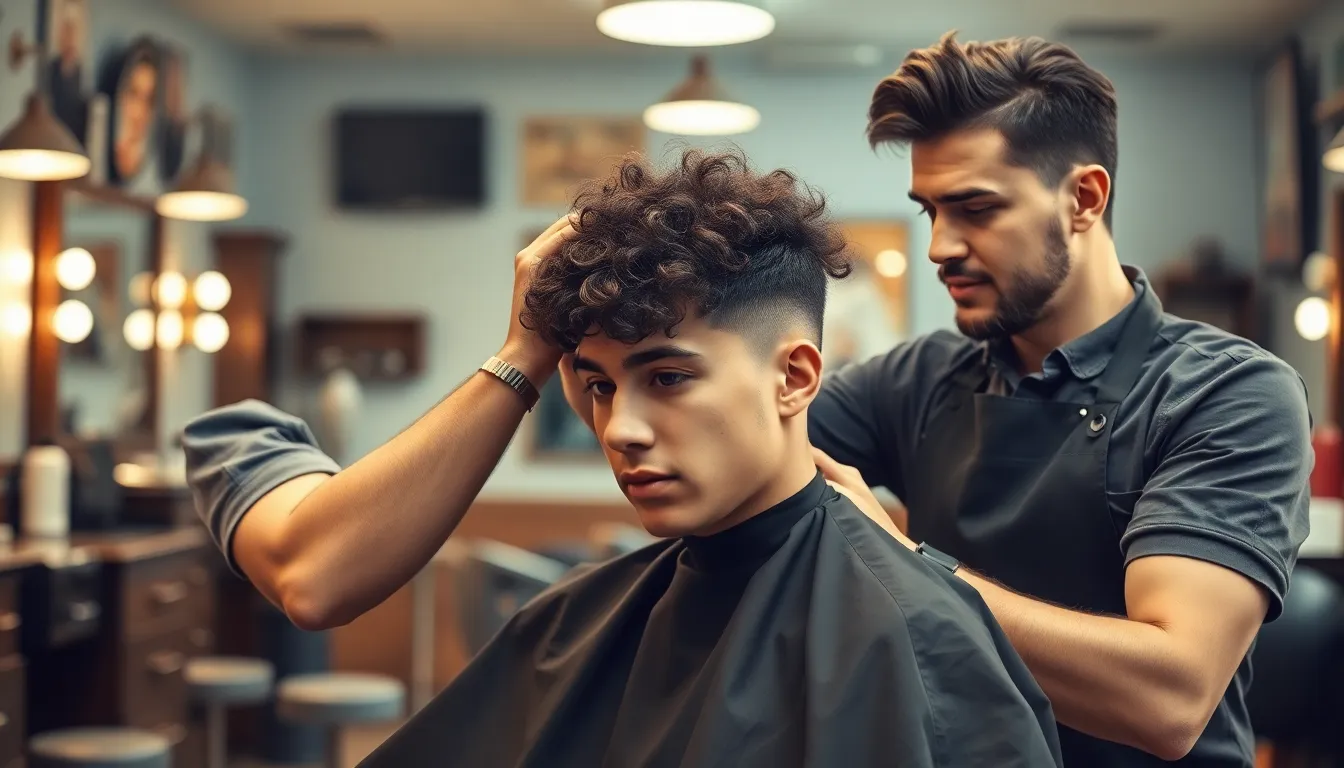
Finding the right professional makes all the difference in achieving a flattering curly haircut that works with your natural texture. Barbers experienced with curly hair understand the unique cutting techniques required to enhance rather than fight your curl pattern.
Questions to Ask Your Stylist
Experience with curly hair should be your first inquiry when vetting potential barbers. Ask directly about their experience cutting men’s curly hair and request to see examples of their curly work through portfolios or social media.
Cutting techniques reveal a stylist’s expertise level with textured hair. Inquire about exact methods they use for curly hair, such as point cutting or dry cutting techniques that preserve curl bounce and shape.
Curl pattern understanding demonstrates whether your barber can work with your exact texture. Request an explanation of how they’ll approach your individual curl pattern and what techniques they’ll use to enhance it.
Maintenance guidance shows a stylist’s commitment to your long term curl health. Ask for recommendations on maintaining your curls between appointments and which styling routine will work best for your lifestyle.
Product suggestions indicate a barber’s knowledge of curl care essentials. Request exact product recommendations for your hair type, including styling creams, leave in conditioners, and tools that complement your new cut.
Red Flags to Watch Out For
Wet cutting only presents a major concern for curly hair clients. Stylists who cut curly hair wet without considering the natural dry curl shape risk creating uneven results since curls shrink and behave differently when dry.
Straightening before cutting signals a fundamental misunderstanding of curly hair needs. Avoid barbers who attempt to straighten curls completely before cutting, as this approach leads to cuts that don’t work with your natural curl pattern.
Aggressive brushing reveals poor curly hair knowledge and technique. Steer clear of stylists who brush curls aggressively or show lack of understanding about different curl patterns, as this causes frizz and damage.
Limited curly hair portfolio suggests insufficient experience with textured hair. Be cautious of barbers who can’t show recent examples of successful curly cuts or seem uncomfortable discussing curl exact techniques.
Building a Long Term Relationship
Regular appointments with a trusted stylist familiar with your curls help achieve consistent, flattering results over time. Schedule cuts every 6 to 8 weeks to maintain shape while allowing your barber to track how your hair grows and responds to different techniques.
Open communication about your styling habits and curl management creates better outcomes. Share honestly about how you style and care for your curls daily, including which products you use and how much time you spend on styling.
Consistent product use following your stylist’s recommendations helps maintain your cut’s shape and your hair’s health. Using the suggested styling products after your haircut ensures your curls look their best between appointments and makes future cuts more predictable.
Feedback and adjustments allow your barber to refine their approach to your exact needs. Discuss what works and what doesn’t after each cut, enabling your stylist to better understand your hair’s unique characteristics and your personal preferences over time.
Conclusion
We’ve covered everything you need to know about choosing and maintaining the perfect haircut for your curly hair. From understanding your curl type to finding the right barber your journey to great-looking curls starts with making informed decisions.
Remember that your curls are unique and deserve a cut that celebrates their natural beauty. Whether you prefer classic styles modern fades or textured cuts the key is working with your hair’s natural pattern rather than against it.
The investment in proper products quality cuts and regular maintenance will pay off with healthier more manageable curls. Trust the process embrace your texture and don’t be afraid to communicate openly with your barber about your styling preferences and lifestyle needs.
Frequently Asked Questions
What are the main types of curly hair men should know about?
Men’s curly hair ranges from Type 2 (loose waves) to Type 4 (tight curls). Understanding your specific curl type, along with hair density and porosity, is crucial for selecting the right haircut and products. This knowledge helps determine how your hair retains moisture and responds to styling, ensuring you choose cuts that enhance rather than fight your natural texture.
How do I choose the right curly haircut for my face shape?
Different face shapes benefit from various curly styles. Consider your facial structure when selecting cuts—some shapes work better with volume on top, while others benefit from shorter sides. The key is balancing your natural curl pattern with proportions that flatter your features, creating harmony between your hair and face shape.
What are the best classic curly haircuts that never go out of style?
Timeless options include the Curly Quiff, Traditional Side Part, and Classic Taper Cut. These styles work with your natural texture while offering versatility for different occasions. Each can be adapted to various curl types and maintained with proper products and techniques, making them reliable choices for any man with curly hair.
Should I cut my curly hair wet or dry?
Always cut curly hair dry. Wet cutting doesn’t show how curls naturally fall and can lead to uneven results when hair dries. Professional barbers experienced with curly hair cut dry to see the natural curl pattern, ensuring each curl is shaped properly and the overall cut maintains its intended style.
What products work best for maintaining curly hair after a cut?
Use hydrating shampoos, deep conditioning treatments, and curl creams that define without weighing hair down. Avoid products with harsh sulfates or heavy oils that can cause buildup. Heat protectants are essential when using styling tools, and leave-in conditioners help maintain moisture between washes.
How often should men with curly hair get haircuts?
Curly hair typically needs trimming every 6-8 weeks to maintain shape and remove damaged ends. However, this varies based on your specific curl type, growth rate, and chosen style. Regular maintenance prevents curls from losing definition and becoming unmanageable while preserving the integrity of your cut.
What are the biggest mistakes to avoid with curly haircuts?
Avoid over-thinning and excessive layering, which can compromise curl integrity. Don’t let barbers brush curly hair aggressively or cut it wet. Excessive heat styling without protection damages curls. Also, avoid choosing cuts based solely on trends rather than what works with your specific curl type and lifestyle needs.
How do I find a barber who understands curly hair?
Ask potential barbers about their experience with curly hair cutting techniques, request to see examples of their curly hair work, and inquire about their approach to cutting curls. Red flags include insisting on wet cuts or aggressive brushing. A good curly hair specialist will discuss your curl type and maintenance routine before cutting.
